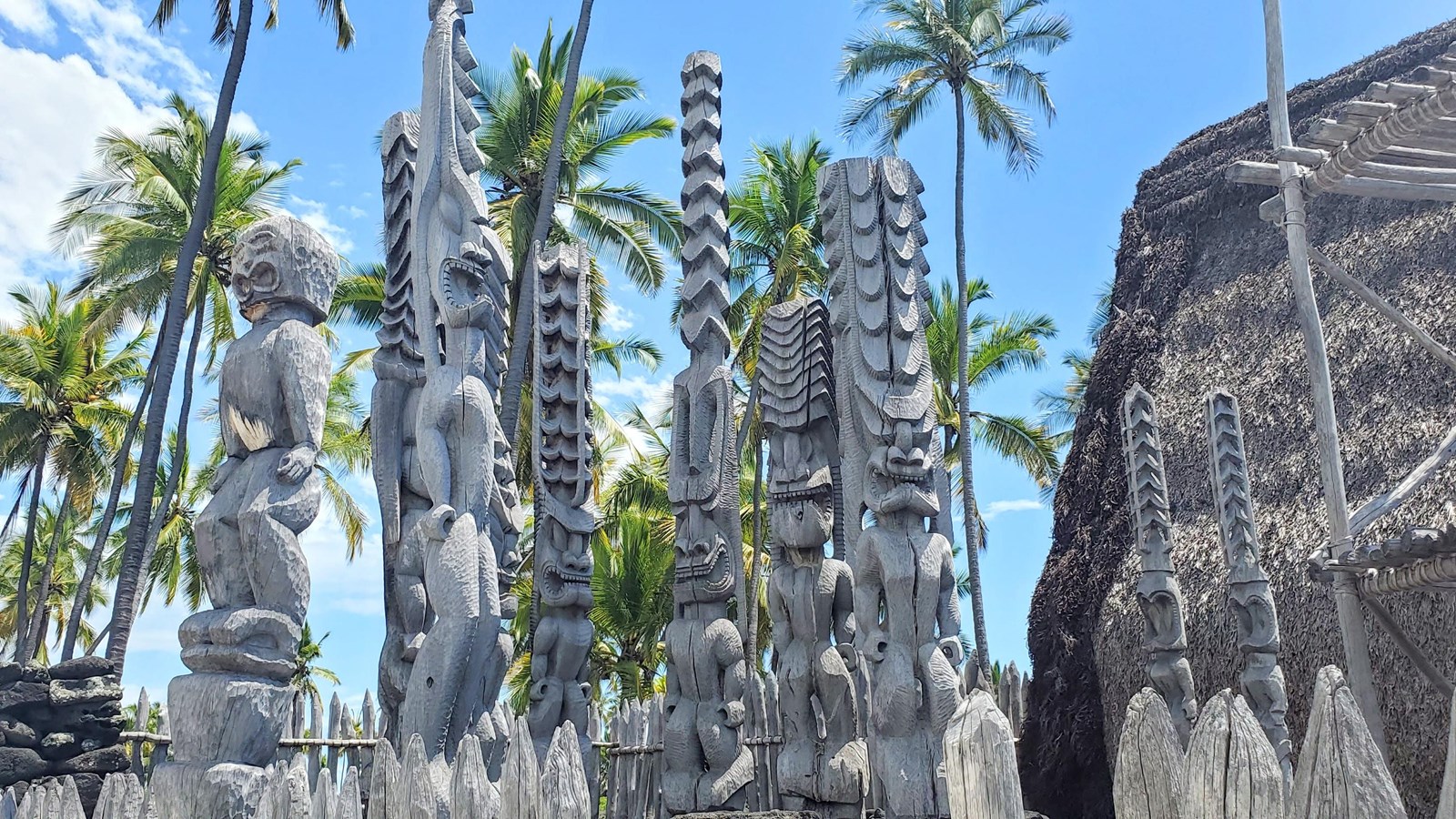Last updated: March 30, 2021
Place
Inner Court Kiʻi at Hale o Keawe

Historical/Interpretive Information/Exhibits
The kiʻi images found within the inner court of Hale o Keawe are the focal point of the heiau (temple). These images are all forms of Lono that represent the various functions of the Puʻuhonua. In the semicircle of kiʻi the images represent the following forms of Lono (from left to right):
Lono-kīnaʽu
Lono-kīnaʽu is the farthest left image when facing the semicircle of the images in the inner court of Hale o Keawe. Lono-kīnaʽu is an akua (god) evoked for the identification of defects and associated closely with the practice of medicine, childbirth, and reproductive health.
Lono-makahialele
Lono-makahialele is often described as the “restless” or “flashing” eyes of Lono in ancient tradition. The “darting eyes of Lono” taught to cast a discerning eye upon potential challenges, and to navigate cautiously; as the famed navigator Pakaʽa did when taking to land at Kaluakoʽi Molokai – navigating the twisting reef-passages if Hikauhi and Kaumanamana. See Lono-makialele in the inner court of Hale o Keawe the second image from the far left when facing the semicircle of images.
Lono-i-ka-ʻoualiʻi
A major akua represented at heiau, Lono-i-ka-ʽoualiʽi is a form of Lono responsible for the sighting and understanding of omens. One important symbol of the aliʽi is the rainbow, represented as the shape of a crescent or arch, frequently appearing in traditional material culture. Lono-i-ka-ʽoualiʽi became a major akua in Hawaiʽi upon the arrival of Laʽamaikahiki, an aliʽi from Tahiti who introduced the worship of this particular aspect of Lono along with the stylized pahu (temple drum) and kāʽekeʽeke (bamboo drum). See Lono-i-ka-ʽoualiʽi in the inner court of Hale o Keawe. When facing the semicircle of images, Lono-i-ka-ʽoualiʽi is the third image from the left.
Lono-mōʻī or Haku ʻŌhiʻa
The central and most important image within the heiau is the mōʽī or “lord of images”, as described my 19th century Hawaiian scholar David Malo. Also termed Haku ʽŌhiʽa, this kiʻi is set in the center of the group of images facing the altar and is the most intricately carved. At Hale o Keawe, Lono mōʽī encompasses the many aspects of Lono in one visualization known as Lono-nui-ākea or “the great expanse” of Lono. The Lono-mōʽī along with the other images of the inner court served as a ceremonial focal point, crucial to the rituals conducted within the heiau.
Lono-iki-aweawealoha
A form of Lono that rises through the body and spirit, invoking the feelings of love and compassion crucial to the holistic practice of healing and restoration, hoʽoponopono, that took place at Puʽuhonua o Hōnaunau. See Lono-iki-aweawealoha in the inner court of Hale o Keawe; the third image from the right when looking directly at the semicircle of kiʽi.
Lono-ʻōpuakau
When facing the semicircle of kiʽi, Lono-ʽōpuakau appears as the second image from right-hand side. The billowing cloud forms of Lono, Lono-ʽōpuakau, is important to the occupations of agriculture and to the reading of omens. O Kona kai ʽōpua I ka laʽi - ʽōpua hīnano I ka malie, a famous saying goes, “Kona with its cloud-billows and calm sea – like a white hīano (Pandanus) blossoms resting in the quiet. This saying speaks to the calm nature of the people of Kona, Hawaiʽi, who look to the clouds for signs of rain and abundance.
Lono-i-ke-ʻeke
Lono-i-ke-ʽeke is a form of Lono important to the keeping of provisions and bountiful harvest. When facing the semicircle of images, Lono-i-ke-ʽeke is the image on the right-hand side.
